Curiosity is half way to its goal
After the rover overcame a dune in Dingo Gap, he climbed onto a new type of surface, resembling the one that was planted on in August 2012. According to him, he rushed to his new intermediate goal - a group of hills called Kimberley. The end point of this annual run - Entry Point in the hills of Murray Buttes is far away.
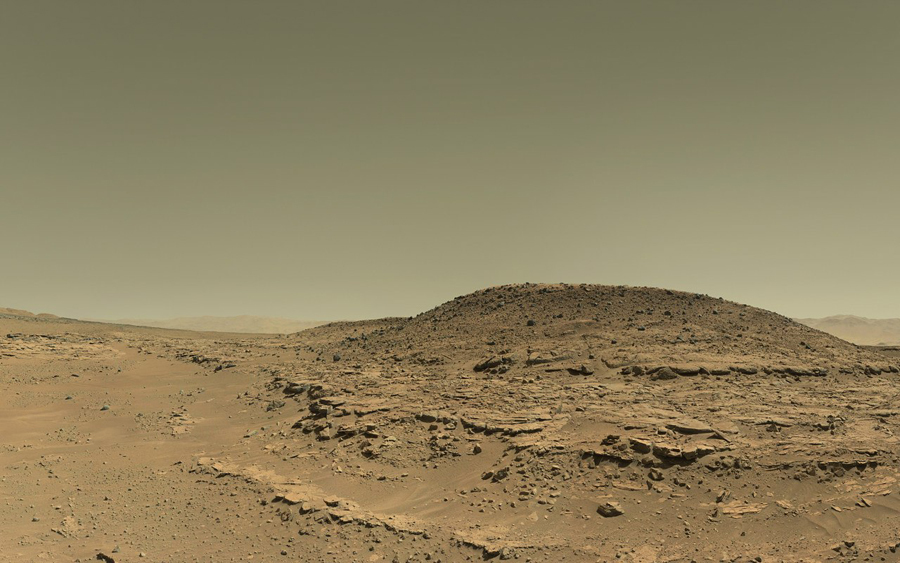
On the desktop .
The previous three kilometers of rocky ground were pretty worn out by the wheels of Curiosity, so the new surface covered with sand and small dunes is very good news.
Although the JPL engineers stressed that they did not see a great threat to the scientific mission in the emerging gaps on the wheels, they took a number of measures to reduce the damage. Prior to Dingo Gap, they roughly halved the daily mileage of the rover: it was 60-80 m, it was 25-35 m. A mandatory daily inspection of the wheels began to be included in the work program. This is necessary to understand how intense the impact of stones. Thanks to this shooting, it was possible to make a video illustrating the movement of Curiosity, the bottom view:
')
The experience gained on Earth suggests that the rover can successfully move on much more smashed wheels. But the nature of the damage that Curiosity receives on Mars and its twin sister on Earth is different. Earth gravity pushes the wheel through the tread and breaks the frame.
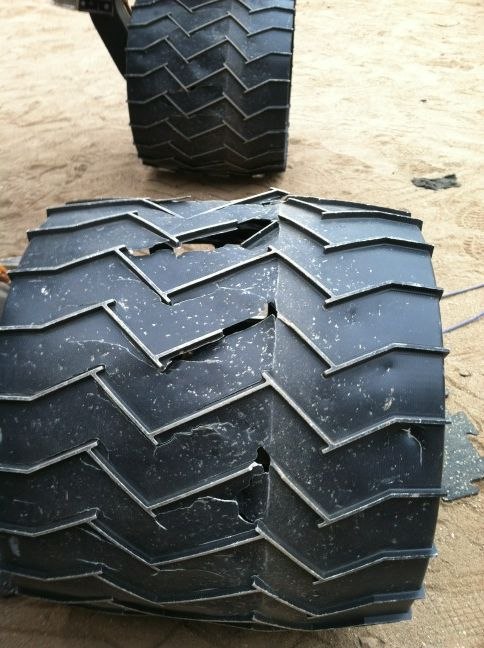
On Mars, the carcass still holds, but sharp stones break through the wheel web.
Curiosity wheels are made of aluminum alloy, and have a diameter of 50 cm. They have an inner rim, several centimeters wide, with curved titanium needles attached to it. The ribs of the frame also serve as a protector, their thickness is 3-4 mm. The main wheel blade with a thickness of only 0.8 mm, so even if the Martian stones could damage it, does not mean that they can repeat this with a frame or a rim. In general, as long as the skeleton is intact, you can not worry about the motor capabilities of the rover.

People often ask the question: why did NASA not use for the manufacture of wheels, for example, titanium? The answer is simple: titanium is twice as hard - you ride a titanium, leave 1-2 scientific instruments on Earth. The same goes for rubber. Composites are also not the best idea, considering the practical vacuum and temperature drops.
The original means of extending the life of the wheels, was the decision to move backwards. Mars rover cameras look back and forth, so they allow this movement. Opportunity, for example, has been moving backwards for several years, only he has problems with electric motors, and not a “tire”. Inspection of the wheels Curiosity showed that the front and middle pairs are subject to the greatest wear and tear. The rear looks quite bearable, so it was decided, in the future, to storm the Martian curbs and curbs with it.
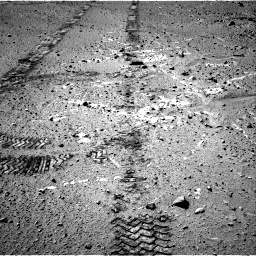
True, the new type of surface allows you to get by with “little blood”, and once again pick up the pace a hundred meters a day.
After Dingo Gap, Kimberley was appointed as the next intermediate science goal. According to satellite imagery, NASA geologists found this group of small hills the most suitable object for studying the local landscape.

On the way to the hills, the rover under my feet, strange grooves appeared, resembling traces of moving stones in Death Valley in California or even some living organisms. However, it seems to me that their explanation is more prosaic - these are half-filled cracks in the ground .
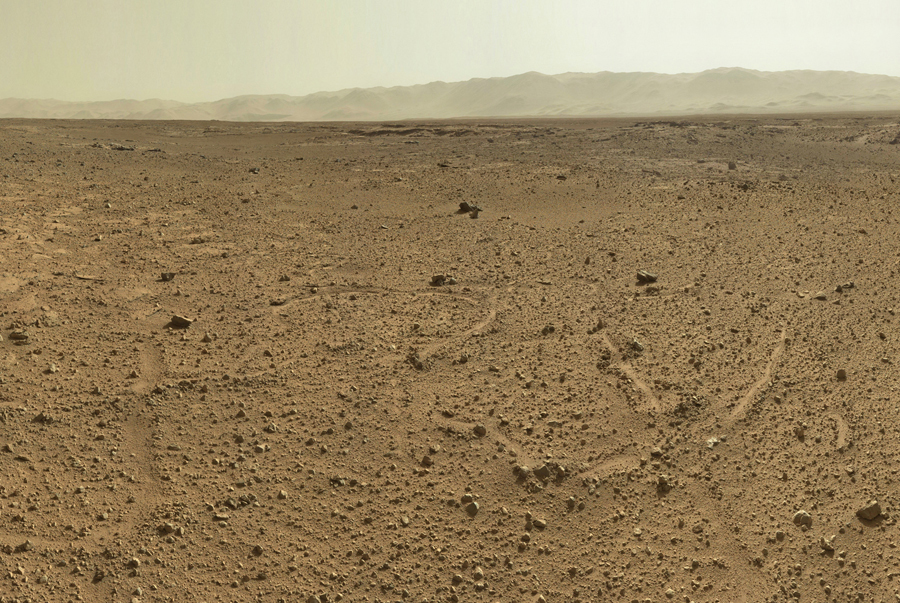
Barely getting to Kimberley, Curiosity began to look for a suitable place for surveys. First, he shot a huge panorama of the area with the right mast camera.

Clicking on the image reveals a large format (17 mb), and you can view it in full size on GigaPan .
Before us are numerous sandstone strata, which are most likely formed at the bottom of the reservoir. Scientists are interested in the fact that different layers react differently to weathering. And, although sand seems to have the same composition, cementing agents are different in the sandstone layers. This difference shows that in different geological periods, in the Gale crater, the water contained different sets of dissolved elements and salts. And their difference can tell more about changes in climate and physical conditions in the past of Mars.
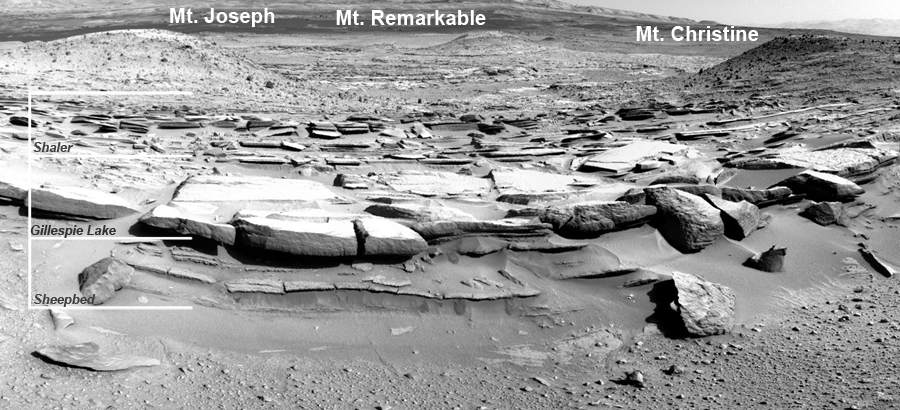
The bottom layer, from those observed before the rover (Sheepbed Formation), is rather loose, is destroyed by the action of wind and sand so intensively that the overlying layer forms a “visor”. A characteristic feature of the lower layer are nodules from a white mineral, most likely gypsum. Similar clusters, under similar conditions, were observed earlier in Yellowknifle Bay.

Above is a powerful concrete-like formation (Gillespie Lake formation). Despite the apparent solidity, upon close inspection, one can see its layered structure and inclusions in the form of small (3-5 mm) slightly rolled pebbles. Shingle is an additional indirect indication of the water origin of the rock, and its incomplete roundness - the fact that this body of water was quite calm.
Above the “slabs” lies limestone - a geological formation first seen in the Shaler site. It is characterized by dense accumulation of clearly separated thin layers. In profile, these layers resemble books. Any paleontologist would have sat next to them and began to stratify the "pages" with a knife. On Earth in such "books" you can find a lot of interesting things, for example, a real herbarium of ancient plants, insect prints and fish skeletons. But Curiosity does not have a knife, and so far, not a single sign of life has appeared on any of the examined fractured layers.
On top of Shaler-type structures in many places along the way, the rover was met by thick dark layers of rock. Most likely it is a lava layer, with breccia and slag fragments. In Kimberley, it has already collapsed, so only three underlying levels will be studied.
It is curious that earlier scientists have already identified three stages in the development of the lake at the bottom of the Gale crater, based on satellite data. Therefore, current research will help to recheck hypotheses based on direct study of bottom material.

Curiosity examined the sediments with a ChemCam laser camera and a MAHLI macro camera. At the same time, he shook out the latest clay samples, which he collected almost a year ago. To ensure the purity of the tools on the manipulator, he carefully examined it.

There was a cause for concern again - a gap was found on the Chimra tool sieve for preparing the soil. The sieve is needed to screen out rock particles less than 0.15 mm — that is the size required for internal chemical and mineralogical analysis instruments. Without it, the quality of research conducted will drop significantly.

American enthusiasts from the Unmannedspaceflight forum saved the panic cries of “Curiosity falling apart” when it was determined that the gap had already been present a year and a half ago and it didn’t prevent research.
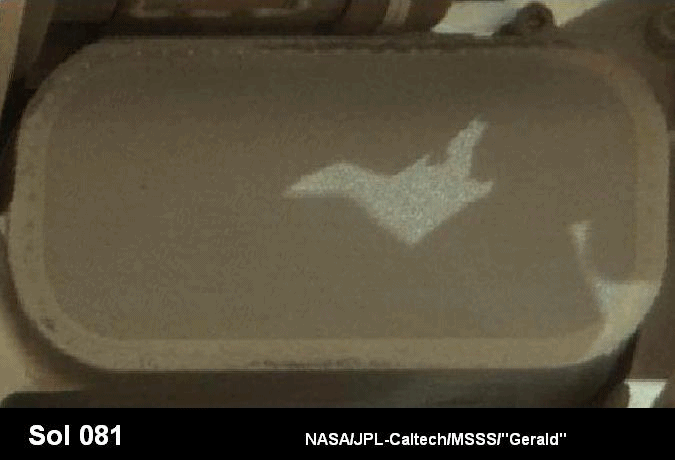
However, for the Curiosity bora he did not find a suitable target, so he continued moving, bypassing Kimberley from the east. Having walked 100 meters, he made another panorama. From this angle, the Shaler beds resemble ice on the river during freezing. But what force has gathered them into such a cluster, while it is too early to speak.

By clicking - large size. Full - on GigaPan .
On the left side of the panorama we see the hill Mt. Remarkable. Even to the left, in the distance, you can see the meteor crater filled with dark sand and the characteristic ripples are not there. I hope in a few months we will be able to look into this crater.
Mars rover proceeded to a closer inspection of Mt. Remarkable, and how he approached him, studying the approaches to Kimberley, is clearly visible in the fresh MRO satellite image.
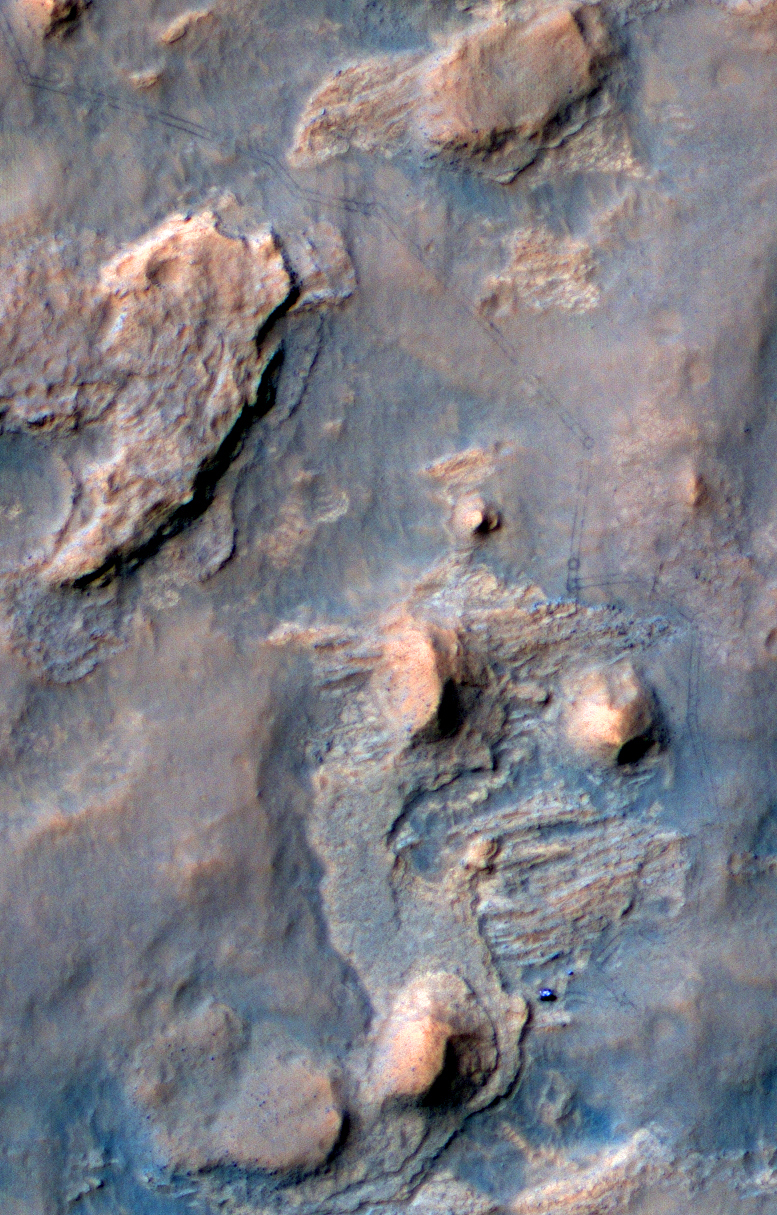
During his study, Kimberley Curiosity made a gift for Mars fans - shot a blue sunset .
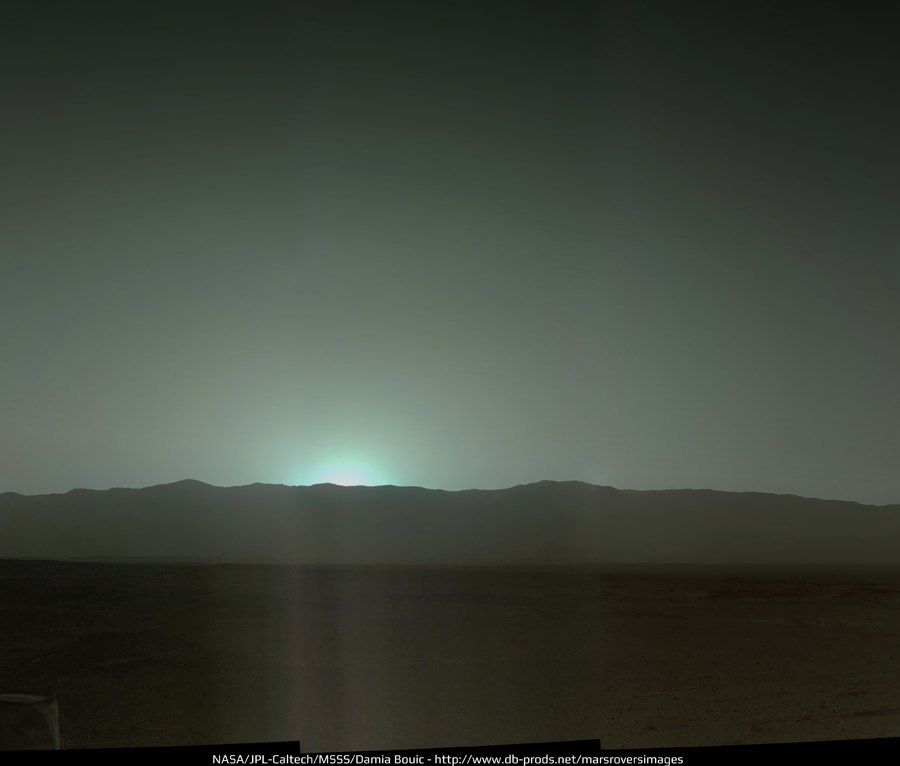
On the desktop .
Now Curiosity continues to search for a suitable place for drilling. We will continue to follow his journey on the next planet.

On the desktop .
The previous three kilometers of rocky ground were pretty worn out by the wheels of Curiosity, so the new surface covered with sand and small dunes is very good news.
Although the JPL engineers stressed that they did not see a great threat to the scientific mission in the emerging gaps on the wheels, they took a number of measures to reduce the damage. Prior to Dingo Gap, they roughly halved the daily mileage of the rover: it was 60-80 m, it was 25-35 m. A mandatory daily inspection of the wheels began to be included in the work program. This is necessary to understand how intense the impact of stones. Thanks to this shooting, it was possible to make a video illustrating the movement of Curiosity, the bottom view:
')
The experience gained on Earth suggests that the rover can successfully move on much more smashed wheels. But the nature of the damage that Curiosity receives on Mars and its twin sister on Earth is different. Earth gravity pushes the wheel through the tread and breaks the frame.

On Mars, the carcass still holds, but sharp stones break through the wheel web.
Curiosity wheels are made of aluminum alloy, and have a diameter of 50 cm. They have an inner rim, several centimeters wide, with curved titanium needles attached to it. The ribs of the frame also serve as a protector, their thickness is 3-4 mm. The main wheel blade with a thickness of only 0.8 mm, so even if the Martian stones could damage it, does not mean that they can repeat this with a frame or a rim. In general, as long as the skeleton is intact, you can not worry about the motor capabilities of the rover.

People often ask the question: why did NASA not use for the manufacture of wheels, for example, titanium? The answer is simple: titanium is twice as hard - you ride a titanium, leave 1-2 scientific instruments on Earth. The same goes for rubber. Composites are also not the best idea, considering the practical vacuum and temperature drops.
The original means of extending the life of the wheels, was the decision to move backwards. Mars rover cameras look back and forth, so they allow this movement. Opportunity, for example, has been moving backwards for several years, only he has problems with electric motors, and not a “tire”. Inspection of the wheels Curiosity showed that the front and middle pairs are subject to the greatest wear and tear. The rear looks quite bearable, so it was decided, in the future, to storm the Martian curbs and curbs with it.

True, the new type of surface allows you to get by with “little blood”, and once again pick up the pace a hundred meters a day.
After Dingo Gap, Kimberley was appointed as the next intermediate science goal. According to satellite imagery, NASA geologists found this group of small hills the most suitable object for studying the local landscape.

On the way to the hills, the rover under my feet, strange grooves appeared, resembling traces of moving stones in Death Valley in California or even some living organisms. However, it seems to me that their explanation is more prosaic - these are half-filled cracks in the ground .

Barely getting to Kimberley, Curiosity began to look for a suitable place for surveys. First, he shot a huge panorama of the area with the right mast camera.

Clicking on the image reveals a large format (17 mb), and you can view it in full size on GigaPan .
Before us are numerous sandstone strata, which are most likely formed at the bottom of the reservoir. Scientists are interested in the fact that different layers react differently to weathering. And, although sand seems to have the same composition, cementing agents are different in the sandstone layers. This difference shows that in different geological periods, in the Gale crater, the water contained different sets of dissolved elements and salts. And their difference can tell more about changes in climate and physical conditions in the past of Mars.

The bottom layer, from those observed before the rover (Sheepbed Formation), is rather loose, is destroyed by the action of wind and sand so intensively that the overlying layer forms a “visor”. A characteristic feature of the lower layer are nodules from a white mineral, most likely gypsum. Similar clusters, under similar conditions, were observed earlier in Yellowknifle Bay.

Above is a powerful concrete-like formation (Gillespie Lake formation). Despite the apparent solidity, upon close inspection, one can see its layered structure and inclusions in the form of small (3-5 mm) slightly rolled pebbles. Shingle is an additional indirect indication of the water origin of the rock, and its incomplete roundness - the fact that this body of water was quite calm.
Expand

Above the “slabs” lies limestone - a geological formation first seen in the Shaler site. It is characterized by dense accumulation of clearly separated thin layers. In profile, these layers resemble books. Any paleontologist would have sat next to them and began to stratify the "pages" with a knife. On Earth in such "books" you can find a lot of interesting things, for example, a real herbarium of ancient plants, insect prints and fish skeletons. But Curiosity does not have a knife, and so far, not a single sign of life has appeared on any of the examined fractured layers.
On top of Shaler-type structures in many places along the way, the rover was met by thick dark layers of rock. Most likely it is a lava layer, with breccia and slag fragments. In Kimberley, it has already collapsed, so only three underlying levels will be studied.
It is curious that earlier scientists have already identified three stages in the development of the lake at the bottom of the Gale crater, based on satellite data. Therefore, current research will help to recheck hypotheses based on direct study of bottom material.

Curiosity examined the sediments with a ChemCam laser camera and a MAHLI macro camera. At the same time, he shook out the latest clay samples, which he collected almost a year ago. To ensure the purity of the tools on the manipulator, he carefully examined it.

There was a cause for concern again - a gap was found on the Chimra tool sieve for preparing the soil. The sieve is needed to screen out rock particles less than 0.15 mm — that is the size required for internal chemical and mineralogical analysis instruments. Without it, the quality of research conducted will drop significantly.

American enthusiasts from the Unmannedspaceflight forum saved the panic cries of “Curiosity falling apart” when it was determined that the gap had already been present a year and a half ago and it didn’t prevent research.

However, for the Curiosity bora he did not find a suitable target, so he continued moving, bypassing Kimberley from the east. Having walked 100 meters, he made another panorama. From this angle, the Shaler beds resemble ice on the river during freezing. But what force has gathered them into such a cluster, while it is too early to speak.

By clicking - large size. Full - on GigaPan .
On the left side of the panorama we see the hill Mt. Remarkable. Even to the left, in the distance, you can see the meteor crater filled with dark sand and the characteristic ripples are not there. I hope in a few months we will be able to look into this crater.
Mars rover proceeded to a closer inspection of Mt. Remarkable, and how he approached him, studying the approaches to Kimberley, is clearly visible in the fresh MRO satellite image.

During his study, Kimberley Curiosity made a gift for Mars fans - shot a blue sunset .

On the desktop .
Now Curiosity continues to search for a suitable place for drilling. We will continue to follow his journey on the next planet.
Source: https://habr.com/ru/post/220649/
All Articles